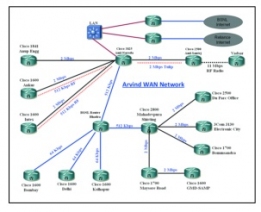Spinning Success - Arvind Limited upgrades to multi-tiered IT set-up

-
tele.net takes a look at the development of the company's telecom and IT infrastructure...
Background
Founded in 1931, Arvind Limited manufactures, sells and exports textiles and garments. The company primarily produces and sells yarn, fabric and branded garments.
Legacy system
In 1995, the company had a manufacturing base in Ahmedabad with marketing offices in Mumbai, Bangalore and New Delhi. Each office functioned independently of the other with little or no connectivity. As such, the requirement of data connectivity was limited and not many connectivity options were available.
In the early days, the textile major's telecom infrastructure comprised a dial-up internet connection, telephone lines and email-based communication.
The shift
In 1998, the company took small steps to upgrade its IT and telecom set-up. To begin with, it opted for an enterprise resource planning (ERP) package, which helped manage all its business-related information and functions from shared data stores.
The company's local area network (LAN) was designed using fibre optic connectivity and Cat 5 cables to connect various departments with the central server. The entire network was designed on a 100 Mbps backbone and 10 Mbps at the desktop-level using products from companies such as Cisco.
The wide area network (WAN) was designed using a 2 Mbps leased line from Bharat Sanchar Nigam Limited (BSNL) as a primary link. The company also invested in radio links as a back-up option to connect various plants across Gujarat. Thereafter, Arvind used Reliance Communications' (RCOM) and Tulip's virtual private network for improving performance, throughput and automatic failover of WAN links. For plants located outside Ahmedabad, the company now uses BSNL's multi-protocol label switching (MPLS) leased lines to connect various plants situated in Mumbai, Pune, Bangalore, Kolhapur, Delhi, etc.
Apart from its LAN and WAN set-up, the company focused on video conferencing, voice over internet protocol (VOIP) and international communications. It uses a 128 kbps ISDN line connectivity, IpVPN, and internet bandwidth. The company uses a 2 Mbps internet connection each from RCOM and BSNL. They use IP-VPN and IPSec VPN at some places as site-to-site VPN connectivity where they have 10-15 computers instead of leased lines. For roaming users, the company uses IPSec software client VPN.
Arvind also has a data centre in place, which serves several purposes. For instance, server uptime is maintained, data recovery and power back-up are easily accessed and storage management, hardware, network operations and end-user support are simplified.
Over the past few years, the company has put other software applications in place as well, including business intelligence and robotic inventory management. As a manufacturing company, a clear and transparent view of inventory was vital to the business. Therefore, inventory management helped in specifying the size and placement of stocked goods and helped determine criteria such as replenishment lead time, asset management, inventory forecasting, valuation, visibility, future price forecasting, etc. Business intelligence, on the other hand, provided the company with a 360- degree view of business operations. It helped in reporting, analysing, data mining, managing business performance, benchmarking standards, etc.
For a company as large and dispersed as Arvind Limited, security is a key concern.
The textile major has implemented several security measures to protect its network.The array of technologies include access log (which is a list of all the requests for individual files that people asked for from a website); security audits; user authentication; unified threat management; and data and network encryption.
The company is also deploying managed application, and network and security services. The benefits accrued include reduction of costs, better management of the telecom network and easy access to IT experts in case of any technical difficulty.
Benefits and challenges
While the company had several benefits, it did not face any major hurdle in implementing the changes for the reason that the employees were willing to adopt new technologies in order to streamline processes.
The benefits were reduced overheads, reliable connectivity and a single, standardised platform for all processes and enhanced productivity.
Going forward, the company plans to re-implement its ERP system.Similarly, its management is planning to increase bandwidth at all locations for better performance and throughput. The company is also planning to use the same infrastructure for unified communications in terms of VOIP and data applications.
In the meantime, Arvind Limited continues to enjoy the benefits of a secure and stable communications and IT infrastructure.
- Most Viewed
- Most Rated
- Most Shared
- Related Articles
- VMC upgrades its telecom infrastructure
- Beyond Boundaries: Telecom tools facilit...
- Telecom Linked: Manufacturing companies ...
- Revamp Results: Hindustan Copper benefit...
- The Right Steps: UIL’s telecom initiat...
- Telecom Priority: Systems upgrade helps ...
- Telecom Makeover: SSL upgrades its syste...
- Moser Baer adopts a modern, integrated c...
- Spinning Success - Arvind Limited upgr...
- Road to Success - Ashok Leyland derive...
No Most Rated articles exists!!
| Your cart is empty |





